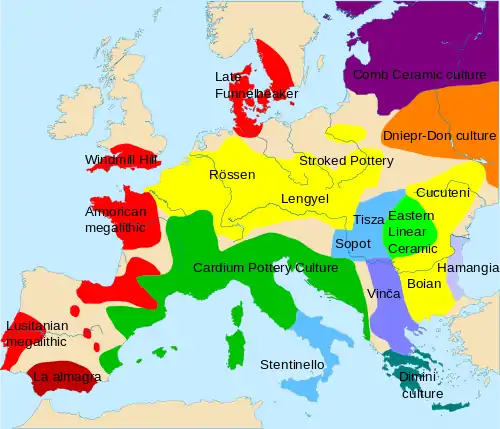Lengyel culture
The Lengyel culture is an archaeological culture of the European Neolithic, centered on the Middle Danube in Central Europe. It flourished from 5000 to 4000 BC, ending with phase IV, e.g., in Bohemia represented by the 'Jordanow/Jordansmühler culture'. It is followed by the Funnel Neck Beaker/TrB culture.[1] The eponymous type site is at Lengyel in Tolna county, Hungary.

It was preceded by the Linear Pottery culture and succeeded by the Corded Ware culture. In its northern extent, overlapped the somewhat later but otherwise approximately contemporaneous Funnelbeaker culture. Also closely related are the Stroke-ornamented ware and Rössen cultures, adjacent to the north and west, respectively.
Subgroups of the Lengyel horizon include the Austrian/Moravian Painted Ware I and II, Aichbühl, Jordanów/Jordanov/Jordansmühl, Schussenried, Gatersleben, etc.
It is a wide interaction sphere or cultural horizon rather than an archaeological culture in the narrow sense. Its distribution overlaps with the Tisza culture and with Stroke-Ornamented Pottery (STK) as far north as Osłonki, central Poland.
Lengyel pottery was found in western Hungary, the Czech Republic, Slovakia, Austria, Poland, and in the Sopot culture of the northern parts of Former Yugoslavia. Influence in pottery styles is found even further afield, in parts of Germany and Switzerland.
Agriculture and stock raising (mainly cattle, but also pigs, and to a lesser extent, ovicaprids) was practiced, though many wild faunal remains have also been recovered. Settlements consisted of small houses as well as trapezoid longhouses. These settlements were sometimes open, sometimes surrounded by a defensive ditch.
Inhumation was in separate cemeteries, in the flexed position with apparently no preference for which side the deceased was laid out in.
Lengyel sites of the later period show signs of the use of copper in form of beads and hammered ribbons, marking the dawn of the Chalcolithic period in Central Europe.
It was associated with the cover-term Old Europe by Marija Gimbutas, though may have been undergone "kurganization" by the Proto-Indo-Europeans and become integrated into the successor Globular Amphora culture.
Genetics
Lipson et al. (2017) and Narasimshan (2019) detected in nine individuals ascribed to the Lengyel culture the Y-Haplogroups H, H1b1, I-M170, I2-M438, G2a2a1(M201), J2a(M172), C(M130), and E1b1b1a1b1(V68). mtDNA extracted were various subclades of U, N, T, H, J, W.[2][3]
References
- Mallory, James P.; Adams, Douglas Q., eds. (1997). Encyclopedia of Indo-European Culture. Fitzroy Dearborn Publishers. pp. 349–50. ISBN 1884964982.
- Lipson 2017.
- Narasimhan 2019.
- Bánffy, Eszter (1997). Cult Objects of the Neolithic Lengyel Culture: Connections and Interpretation. David Brown Book Co. ISBN 9789638046161.
Sources
- Lipson, Mark (November 16, 2017). "Parallel palaeogenomic transects reveal complex genetic history of early European farmers". Nature. Nature Research. 551 (7680): 368–372. Bibcode:2017Natur.551..368L. doi:10.1038/nature24476. PMC 5973800. PMID 29144465.
- Narasimhan, Vagheesh M. (September 6, 2019). "The formation of human populations in South and Central Asia". Science. American Association for the Advancement of Science. 365 (6457): eaat7487. bioRxiv 10.1101/292581. doi:10.1126/science.aat7487. PMC 6822619. PMID 31488661.
External links
- The Lengyel Culture Sphere by Maximilian O. Baldia